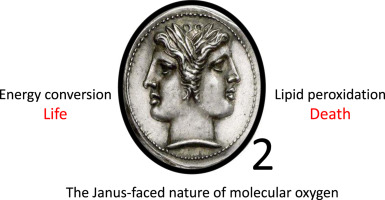当前位置:
X-MOL 学术
›
Free Radical Bio. Med.
›
论文详情
Our official English website, www.x-mol.net, welcomes your feedback! (Note: you will need to create a separate account there.)
Lipid peroxidation and ferroptosis: The role of GSH and GPx4.
Free Radical Biology and Medicine ( IF 7.4 ) Pub Date : 2020-03-09 , DOI: 10.1016/j.freeradbiomed.2020.02.027 Fulvio Ursini 1 , Matilde Maiorino 1
Free Radical Biology and Medicine ( IF 7.4 ) Pub Date : 2020-03-09 , DOI: 10.1016/j.freeradbiomed.2020.02.027 Fulvio Ursini 1 , Matilde Maiorino 1
Affiliation

|
Ferroptosis (FPT) is a form of cell death due to missed control of membrane lipid peroxidation (LPO). According to the axiomatic definition of non-accidental cell death, LPO takes place in a scenario of altered homeostasis. FPT, differently from apoptosis, occurs in the absence of any known specific genetically encoded death pathway or specific agonist, and thus must be rated as a regulated, although not "programmed", death pathway. It follows that LPO is under a homeostatic metabolic control and is only permitted when indispensable constraints are satisfied and the antiperoxidant machinery collapses. The activity of the selenoperoxidase Glutathione Peroxidase 4 (GPx4) is the cornerstone of the antiperoxidant defence. Converging evidence on both mechanism of LPO and GPx4 enzymology indicates that LPO is initiated by alkoxyl radicals produced by ferrous iron from the hydroperoxide derivatives of lipids (LOOH), traces of which are the unavoidable drawback of aerobic metabolism. FPT takes place when a threshold has been exceeded. This occurs when the major conditions are satisfied: i) oxygen metabolism leading to the continuous formation of traces of LOOH from phospholipid-containing polyunsaturated fatty acids; ii) missed enzymatic reduction of LOOH; iii) availability of ferrous iron from the labile iron pool. Although the effectors impacting on homeostasis and leading to FPT in physiological conditions are not known, from the available knowledge on LPO and GPx4 enzymology we propose that it is aerobic life itself that, while supporting bioenergetics, is also a critical requisite of FPT. Yet, when the homeostatic control of the steady state between LOOH formation and reduction is lost, LPO is activated and FPT is executed.
中文翻译:

脂质过氧化和肥大症:GSH和GPx4的作用。
由于缺少对膜脂质过氧化(LPO)的控制,肥大症(FPT)是细胞死亡的一种形式。根据非偶然性细胞死亡的公理定义,LPO发生在动态平衡改变的情况下。与细胞凋亡不同,FPT在不存在任何已知的特定遗传编码死亡途径或特异性激动剂的情况下发生,因此必须将其评定为受调节的死亡途径,尽管不是“编程的”死亡途径。因此,LPO受稳态代谢控制,并且仅当满足必不可少的限制条件且抗过氧化物机制崩溃时才允许使用。硒过氧化物酶谷胱甘肽过氧化物酶4(GPx4)的活性是抗过氧化物防御的基石。关于LPO和GPx4酶学机制的越来越多的证据表明,LPO由亚铁从脂质的氢过氧化物衍生物(LOOH)生成的烷氧基自由基引发,其痕迹是有氧代谢不可避免的缺点。超过阈值时会发生FPT。当满足主要条件时会发生这种情况:i)氧代谢导致从含磷脂的多不饱和脂肪酸连续形成痕量的LOOH;ii)错过了LOOH的酶促还原;iii)从不稳定铁矿池中获取二价铁。尽管尚不知道在生理条件下会影响稳态和导致FPT的效应子,但根据有关LPO和GPx4酶学的现有知识,我们提出,有氧生命本身支持生物能,也是FPT的关键条件。然而,当失去在LOOH形成和还原之间的稳态的稳态控制时,将激活LPO并执行FPT。
更新日期:2020-03-09
中文翻译:

脂质过氧化和肥大症:GSH和GPx4的作用。
由于缺少对膜脂质过氧化(LPO)的控制,肥大症(FPT)是细胞死亡的一种形式。根据非偶然性细胞死亡的公理定义,LPO发生在动态平衡改变的情况下。与细胞凋亡不同,FPT在不存在任何已知的特定遗传编码死亡途径或特异性激动剂的情况下发生,因此必须将其评定为受调节的死亡途径,尽管不是“编程的”死亡途径。因此,LPO受稳态代谢控制,并且仅当满足必不可少的限制条件且抗过氧化物机制崩溃时才允许使用。硒过氧化物酶谷胱甘肽过氧化物酶4(GPx4)的活性是抗过氧化物防御的基石。关于LPO和GPx4酶学机制的越来越多的证据表明,LPO由亚铁从脂质的氢过氧化物衍生物(LOOH)生成的烷氧基自由基引发,其痕迹是有氧代谢不可避免的缺点。超过阈值时会发生FPT。当满足主要条件时会发生这种情况:i)氧代谢导致从含磷脂的多不饱和脂肪酸连续形成痕量的LOOH;ii)错过了LOOH的酶促还原;iii)从不稳定铁矿池中获取二价铁。尽管尚不知道在生理条件下会影响稳态和导致FPT的效应子,但根据有关LPO和GPx4酶学的现有知识,我们提出,有氧生命本身支持生物能,也是FPT的关键条件。然而,当失去在LOOH形成和还原之间的稳态的稳态控制时,将激活LPO并执行FPT。


























 京公网安备 11010802027423号
京公网安备 11010802027423号